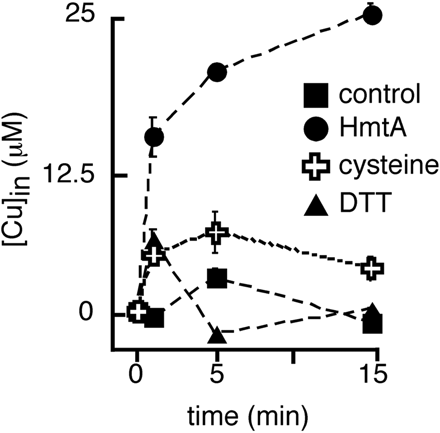Team:Groningen/Project/Transport
From 2009.igem.org
Svenjurgens (Talk | contribs) (→Introduction) |
(creating the Heavy metal accumulation paragraph) |
||
| Line 78: | Line 78: | ||
===Literature=== | ===Literature=== | ||
1. Meng, Y., Liu, Z. & Rosen, B.P. As(III) and Sb(III) Uptake by GlpF and Efflux by ArsB in Escherichia coli. J. Biol. Chem. 279, 18334-18341(2004). | 1. Meng, Y., Liu, Z. & Rosen, B.P. As(III) and Sb(III) Uptake by GlpF and Efflux by ArsB in Escherichia coli. J. Biol. Chem. 279, 18334-18341(2004). | ||
| + | |||
| + | ==Heavy metal accumulation== | ||
| + | Once heavy metals have entered the cell it is key to keep them there. As these metals are toxic to cell survival in critical amounts evolution has provided us with biological detoxicification proteins such as [http://en.wikipedia.org/wiki/Metallothionein metallothioneins]. These proteins can aid us in our quest to accumulate a variaty of heavy metals as they bind to a wide range of metals including cadmium, zinc, mercury, copper, arsenic, silver, etc.. | ||
Revision as of 14:21, 7 June 2009
[http://2009.igem.org/Team:Groningen http://2009.igem.org/wiki/images/f/f1/Igemhomelogo.png]
|
|
| ||||||||||||||||||||||||||||||||||||||||||||||||||||||||||||||||||||||||||||||||||||||||||||||||||||||||||||||||||||||||||||||||||||||||||||||||||||||||||||||||||||||||||||||||||||||||||||||||||||||||||||||||||||||||||||||||||||||||||||||||||||||||||||||||||||||||||||||||||||||||||||||||||||||||||||||||||||||||||||||||||||||||||||||||||||||||||||||||||||||||||||||||||||||||||||||||||||||||||||
|---|---|---|---|---|---|---|---|---|---|---|---|---|---|---|---|---|---|---|---|---|---|---|---|---|---|---|---|---|---|---|---|---|---|---|---|---|---|---|---|---|---|---|---|---|---|---|---|---|---|---|---|---|---|---|---|---|---|---|---|---|---|---|---|---|---|---|---|---|---|---|---|---|---|---|---|---|---|---|---|---|---|---|---|---|---|---|---|---|---|---|---|---|---|---|---|---|---|---|---|---|---|---|---|---|---|---|---|---|---|---|---|---|---|---|---|---|---|---|---|---|---|---|---|---|---|---|---|---|---|---|---|---|---|---|---|---|---|---|---|---|---|---|---|---|---|---|---|---|---|---|---|---|---|---|---|---|---|---|---|---|---|---|---|---|---|---|---|---|---|---|---|---|---|---|---|---|---|---|---|---|---|---|---|---|---|---|---|---|---|---|---|---|---|---|---|---|---|---|---|---|---|---|---|---|---|---|---|---|---|---|---|---|---|---|---|---|---|---|---|---|---|---|---|---|---|---|---|---|---|---|---|---|---|---|---|---|---|---|---|---|---|---|---|---|---|---|---|---|---|---|---|---|---|---|---|---|---|---|---|---|---|---|---|---|---|---|---|---|---|---|---|---|---|---|---|---|---|---|---|---|---|---|---|---|---|---|---|---|---|---|---|---|---|---|---|---|---|---|---|---|---|---|---|---|---|---|---|---|---|---|---|---|---|---|---|---|---|---|---|---|---|---|---|---|---|---|---|---|---|---|---|---|---|---|---|---|---|---|---|---|---|---|---|---|---|---|---|---|---|---|---|---|---|---|---|---|---|---|---|---|---|---|---|---|---|---|---|---|---|---|---|---|---|---|---|---|---|---|---|---|---|---|---|---|---|---|---|---|---|---|---|---|---|---|---|---|---|---|
Introduction
We are trying to find suitable systems capable of isolating heavy metals from the environment. There are several different mechanisms to achieve such a thing. We examined 3 kinds:
- Metal transporters, that transport the metal from the environment (ie. wastewater) to the cytoplasm
- Uncoupled
- Coupled with 'helper' protein
- Metal binding proteins in the periplasm
We will investigate severals systems, to find which are suitable for the final design. the following systems are under concideration.
- Copper /zinc uptake via HmtA
- heavy metal uptake coupled to citrate via efCitH
- Arsenite uptake via GlpF
- Periplasmic accumulation of heavy metals via Mer Operon.
HmtA

HmtA, heavy metal transporter A from Pseudomonas aeruginosa Q9I147 is a P-type ATPase importer. It mediates the uptake of Copper (Cu) and Zinc (Zn) and is functionally expressed in E.coli.
>gi|81857196|sp|Q9I147|Q9I147_PSEAE Probable cation-transporting P-type ATPase
| Enzyme | Number of Sites |
|---|---|
| EcoRI | 0 |
| XbaI | 0 |
| NotI | 0 |
| SpeI | 0 |
| PstI | 2 |
Missing information/To do
- Expression assesment
- Stability
- Level
- Functional assesment
- Uptake speed
- Affinity
- Electrolyte potential generating force
- Eliminate BioBrick restriction sites
Literature
Lewinson O., Lee A.T., Rees D.C. 2009. A P-type ATPase importer that discriminates between essential and toxic transition metals. PNAS. vol. 106, no. 12, p. 4677-4682.
Mer operon
Missing information
Literature
Lewinson O., Lee A.T., Rees D.C. 2009. A P-type ATPase importer that discriminates between essential and toxic transition metals. PNAS. vol. 106, no. 12, p. 4677-4682.
GlpF
Missing information
Literature
1. Meng, Y., Liu, Z. & Rosen, B.P. As(III) and Sb(III) Uptake by GlpF and Efflux by ArsB in Escherichia coli. J. Biol. Chem. 279, 18334-18341(2004).
 "
"